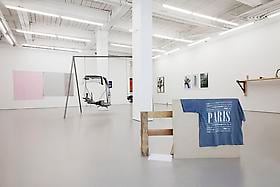
Taking its title from the 17th-century British philosopher John Locke, “Idea Is the Object” features the variously reality-based efforts of 13 artists from the United States and Europe. Veering between routine and impressive, it has been organized by Tracy Parker, a curatorial assistant in contemporary art at the Art Institute of Chicago, and Pavan Segal, a child and adolescent psychiatrist.
“Idea is the object of thinking,” was Locke’s exact phrase, and it reflects his thesis — a wellspring of empirical philosophy — that human knowledge is based entirely on experience of the world, its events and materials. Implicit in this is the notion that the material world is full of ideas awaiting human extrapolation and, perhaps, use by artists.
That is what happens in this show, anyway, which might also have been titled “Further Adventures in Appropriation and/or Collage,” since the works on hand almost invariably rearrange bits of reality. In a 2005 slide-projection piece that is belated yet timelier than ever, Sharon Hayes has herself photographed in the Wall Street area holding a sign urging ratification of the Equal Rights Amendment, while nearby Amalia Pica has taped confetti to the floor, implying a state of permanent festiveness or disarray. Mitzi Pederson, Jacob Dahl Jurgensen, John Henderson, Henrik Olai Kaarstein and Andreas Eriksson investigate forms of two-dimensional abstraction, and even painting, using materials with forthright, often deconstructive directness. Deborah Ligorio, Andy Boot and, most impressively, Mateo Tannatt assemble or simply arrange existing images, materials or objects. In three color photographs Kathrin Sonntag considers the visual echoes between green plants and a green belt.
The selection is bracketed by two excellent videos. Candice Breitz’s “Factum Tremblay” (2009) is a dual-channel digital video in which gay female identical twins recount coming out to each other, their farming family’s reaction to their homosexuality, and other experiences of otherness, like growing up as French Canadians in English-speaking Ontario. The brilliantly edited (implicitly collagelike) back-and-forth between the identically dressed women transcends documentary, forming an intricately layered meditation on difference that has the rhythm of a performance.
In the 2007 work “Stealing Beauty,” the artist Guy Ben-Ner inserts himself, along with his wife, their two children and some video cameras, into the furniture displays of an Ikea store. Moving among the displays, they conduct a reasonable facsimile of family life. Dishes are done, discipline imposed, discussions held (private property is a topic), and everyone tucks in for the night — in numerous beds — as Ikea’s other customers wander through.
A fiction staged within a larger fiction, Mr. Ben-Ner’s video implies with particular sharpness the show’s underlying idea (or object): that the world is ripe for, and better understood through, the form of thinking that is art.
Roberta Smith
Friday August 3rd, 2012, page C25
http://www.nytimes.com/2012/08/03/arts/design/idea-is-the-object.html